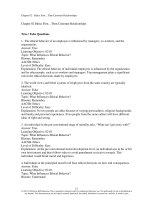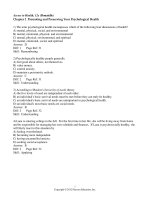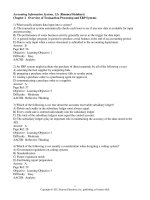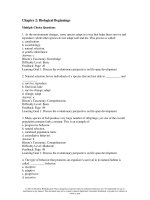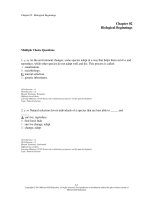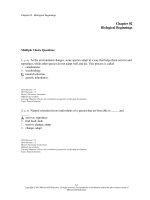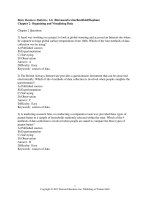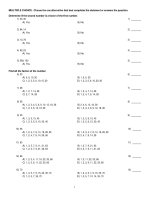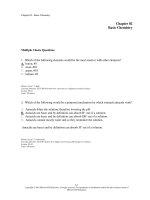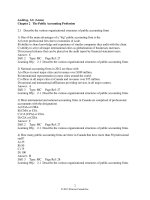Economic development 12th edition todaro test bank
Bạn đang xem bản rút gọn của tài liệu. Xem và tải ngay bản đầy đủ của tài liệu tại đây (456.74 KB, 42 trang )
Chapter 2—Economic Tools and Economic Systems
MULTIPLE CHOICE
1. Opportunity cost exists because
a. technology is fixed at any point in time
b. the law of comparative advantage is working
c. resources are scarce but wants are unlimited
d. the value of lost opportunities varies from person to person
e. efficiency is measured by the monetary cost of an activity
ANS: C
PTS: 1
DIF: Moderate
LOC: Scarcity, tradeoffs, and opportunity cost
NAT: Reflective Thinking
TOP: Opportunity Cost
2. Opportunity cost is the difference between the benefits and the costs of a choice.
a. True
b. False
ANS: B
PTS: 1
DIF: Moderate
LOC: Scarcity, tradeoffs, and opportunity cost
NAT: Analytic
TOP: Opportunity Cost
3. Opportunity cost is always measured in dollar terms, rather than in terms of real goods and services.
a. True
b. False
ANS: B
PTS: 1
DIF: Moderate
LOC: Scarcity, tradeoffs, and opportunity cost
NAT: Analytic
TOP: Opportunity Cost
4. A rational decision maker engages in an activity if that activity is more attractive than the best
alternative.
a. True
b. False
ANS: A
PTS: 1
DIF: Moderate
LOC: Scarcity, tradeoffs, and opportunity cost
NAT: Analytic
TOP: Opportunity Cost
5. The Sultan of Brunei, one of the world's richest people, does not face the problem of scarcity.
a. True
b. False
ANS: B
PTS: 1
DIF: Easy
LOC: Scarcity, tradeoffs, and opportunity cost
NAT: Reflective Thinking
TOP: Opportunity Cost
6. Opportunity cost is defined
a. only in terms of money spent
b. as the value of all alternatives not chosen
c. as the value of the best alternative not chosen
d. as the difference between the benefits from a choice and the benefits from the next best
alternative
e. as the difference between the benefits from a choice and the costs of that choice
ANS: C
PTS: 1
DIF: Moderate
LOC: Scarcity, tradeoffs, and opportunity cost
Chapter 2—Economic Tools and Economic Systems
NAT: Analytic
TOP: Opportunity Cost
1
7. Suppose you have an hour before your next class starts. You can either read a book, get something to
eat, or take a nap. The opportunity cost of getting something to eat is
a. the cost of what you eat
b. the value of reading and sleeping
c. the loss of value from not reading or sleeping
d. the net benefit of sleeping for another hour
e. impossible to determine because the most preferred alternative is not known
ANS: E
PTS: 1
DIF: Moderate
LOC: Scarcity, tradeoffs, and opportunity cost
NAT: Reflective Thinking
TOP: Opportunity Cost
8. The opportunity cost of an activity is
a. zero if you choose the activity voluntarily
b. the amount of money spent on the activity
c. the value of the best alternative not chosen
d. the sum of benefits from all of the sacrificed alternatives
e. the difference between the benefits and the costs of that activity
ANS: C
PTS: 1
DIF: Moderate
LOC: Scarcity, tradeoffs, and opportunity cost
NAT: Analytic
TOP: Opportunity Cost
9. The opportunity cost of an activity
a. depends on the individual's subjective values and opinions
b. is the same for everyone
c. must be calculated and known before undertaking that activity
d. is irrelevant to decision making
e. is not related to time
ANS: A
PTS: 1
DIF: Easy
LOC: Scarcity, tradeoffs, and opportunity cost
NAT: Reflective Thinking
TOP: Opportunity Cost
10. Your opportunity cost of choosing a particular activity
a. can be easily and accurately calculated
b. cannot even be estimated
c. does not change over time
d. varies, depending on time and circumstances
e. is measured by the money you spend on the activity
ANS: D
PTS: 1
DIF: Easy
LOC: Scarcity, tradeoffs, and opportunity cost
NAT: Reflective Thinking
TOP: Opportunity Cost
11. The opportunity cost of college is the same for all students who are receiving full-tuition scholarships.
a. True
b. False
ANS: B
PTS: 1
DIF: Easy
LOC: Scarcity, tradeoffs, and opportunity cost
TOP: CASE STUDY: The Opportunity Cost of College
Chapter 2—Economic Tools and Economic Systems
NAT: Reflective Thinking
2
12. The opportunity cost of going to college is best measured by the
a. cost of room and board
b. cost of tuition
c. cost of room and board plus tuition
d. income forgone by not working, plus tuition
e. income forgone by not working, plus tuition and room and board
ANS: D
PTS: 1
DIF: Moderate
LOC: Scarcity, tradeoffs, and opportunity cost
TOP: CASE STUDY: The Opportunity Cost of College
NAT: Analytic
13. Suppose you have a choice of working full-time during the summer or going full-time to summer
school. Summer tuition and books are $2,200. If you worked, you could make $7,000. Your rent is
$1,000 for the summer, regardless of your choice. The opportunity cost of going to summer school is,
therefore,
a. $2,200
b. $7,000
c. $8,000
d. $9,200
e. $10,200
ANS: D
PTS: 1
DIF: Hard
LOC: Scarcity, tradeoffs, and opportunity cost
TOP: CASE STUDY: The Opportunity Cost of College
NAT: Reflective Thinking
14. Attending college can be viewed as a form of
a. investment in which costs are borne today and benefits are received in the future
b. investment in which benefits are received today and costs are borne in the future
c. consumption, because learning is an enjoyable activity
d. leisure, because learning is an enjoyable activity
e. saving for the future
ANS: A
PTS: 1
DIF: Moderate
LOC: Scarcity, tradeoffs, and opportunity cost
TOP: CASE STUDY: The Opportunity Cost of College
NAT: Reflective Thinking
15. The cost of attending college
a. is entirely monetary and consists of expenditures on tuition, books, transportation, and
meals
b. is not monetary, but consists solely of forgone income
c. is the most valued alternative given up to attend college
d. is negligible for most people, because they really have no choice but to attend college
e. is the same whether you attend a public or a private college
ANS: C
PTS: 1
DIF: Moderate
LOC: Scarcity, tradeoffs, and opportunity cost
TOP: CASE STUDY: The Opportunity Cost of College
Chapter 2—Economic Tools and Economic Systems
NAT: Reflective Thinking
3
16. Expenses for room and board
a. are opportunity costs of attending college, because they are subsidized by the government
or by the college
b. are opportunity costs of attending college since they involve cash expenditures
c. are opportunity costs of attending college if you are on scholarship, but not otherwise
d. are not usually part of the opportunity cost of attending college, because you would have
to live somewhere and eat something even if you didn't attend college
e. are not usually part of the opportunity cost of attending college, because they are already
included in room and board charges, and we wish to avoid double counting
ANS: D
PTS: 1
DIF: Moderate
LOC: Scarcity, tradeoffs, and opportunity cost
TOP: CASE STUDY: The Opportunity Cost of College
NAT: Analytic
17. The opportunity cost of going to college includes the costs of tuition, books, fees, and
a. nothing else
b. housing
c. housing and food
d. earnings forgone by not working full-time
e. housing, food, and earnings forgone by not working full-time
ANS: D
PTS: 1
DIF: Moderate
LOC: Scarcity, tradeoffs, and opportunity cost
TOP: CASE STUDY: The Opportunity Cost of College
NAT: Analytic
18. Opportunity cost is objective; therefore, its value does not change as circumstances change.
a. True
b. False
ANS: B
PTS: 1
DIF: Moderate
LOC: Scarcity, tradeoffs, and opportunity cost
TOP: Opportunity Cost Is Subjective
NAT: Analytic
19. Which economic concept does the expression "time is money" reflect?
a. opportunity cost
b. specialization
c. market exchange
d. comparative advantage
e. efficiency
ANS: A
PTS: 1
DIF: Easy
LOC: Scarcity, tradeoffs, and opportunity cost
TOP: Opportunity Cost Is Subjective
Chapter 2—Economic Tools and Economic Systems
NAT: Reflective Thinking
4
20. A test was scheduled for Monday morning, but you went to a party on Saturday night. If you hadn't
attended the party, you could have studied for the test or gone to a movie. Which of the following is
true?
a. The opportunity cost of going to the movie is studying for the test.
b. The opportunity cost of going to the party is the movie.
c. The opportunity cost of going to the party is both the movie and the study time.
d. Because you could go to the party only that night but could go to a movie any time, the
opportunity cost of the party is the study time.
e. From the above information, it's not possible to determine the opportunity cost of
attending the party.
ANS: E
PTS: 1
DIF: Hard
LOC: Scarcity, tradeoffs, and opportunity cost
TOP: Opportunity Cost Is Subjective
NAT: Reflective Thinking
21. The term opportunity cost suggests that
a. in any exchange situation where one person gains, someone else must lose
b. not all individuals make the most of life's opportunities
c. executives do not always recognize opportunities for profit as quickly as they should
d. the only factor that is important in decision making is cost
e. because goods are scarce, in order to get some good you must give up some other good in
return
ANS: E
PTS: 1
DIF: Moderate
LOC: Scarcity, tradeoffs, and opportunity cost
TOP: Opportunity Cost Is Subjective
NAT: Reflective Thinking
22. If you enjoy playing golf, the opportunity cost of cleaning your room
a. is the same on sunny days as it is on rainy days
b. is greater on sunny days than it is on rainy days
c. is smaller on sunny days than it is on rainy days
d. does not change with the weather conditions
e. is equal to the opportunity cost of any other chore you have to do that day
ANS: B
PTS: 1
DIF: Easy
LOC: Scarcity, tradeoffs, and opportunity cost
TOP: Opportunity Cost Is Subjective
NAT: Reflective Thinking
23. Melissa is a self-employed lawyer who chooses a higher-priced restaurant 2 miles from home over a
cheaper restaurant 15 miles from home. Which of the following is the most likely explanation for her
behavior?
a. The opportunity cost of her time is very low.
b. She doesn't take travel time into consideration.
c. She doesn't like to cook or doesn't know how.
d. The prices at the more expensive restaurant understate the opportunity cost of eating there.
e. The higher monetary cost of the more expensive restaurant is offset by the higher
opportunity cost of the lower-priced restaurant.
ANS: E
PTS: 1
DIF: Moderate
LOC: Scarcity, tradeoffs, and opportunity cost
TOP: Opportunity Cost Is Subjective
Chapter 2—Economic Tools and Economic Systems
NAT: Reflective Thinking
5
24. The opportunity cost of a particular activity
a. must be the same for everyone
b. is the value of all alternative activities that are forgone
c. has a maximum value equal to the minimum wage
d. varies from person to person
e. can usually be known with certainty
ANS: D
PTS: 1
DIF: Easy
LOC: Scarcity, tradeoffs, and opportunity cost
TOP: Opportunity Cost Is Subjective
NAT: Reflective Thinking
25. The opportunity cost of an activity is best measured
a. only by the monetary costs
b. by the number of alternative activities that were forgone
c. by the cost difference between the chosen activity and the next best alternative
d. by the value expected from the best alternative that is forgone
e. as the time wasted choosing among various activities
ANS: D
PTS: 1
DIF: Moderate
LOC: Scarcity, tradeoffs, and opportunity cost
TOP: Opportunity Cost Is Subjective
NAT: Analytic
26. A university should not disband its football team if it has already paid for the stadium.
a. True
b. False
ANS: B
PTS: 1
DIF: Hard
LOC: Scarcity, tradeoffs, and opportunity cost
NAT: Reflective Thinking
TOP: Sunk Cost and Choice
27. Suppose you have purchased a non-refundable plane ticket and, at the last moment, you cannot take
the trip. You can, however, sell the ticket. If you paid $700 for the ticket, the cost of sending the ticket
to someone through overnight mail is $20, and you spend $10 on a courier to get the ticket to the post
office for overnight delivery, what is the minimum you should accept for the ticket?
a. $700 because that is what the ticket cost.
b. $720 because that is the cost of the ticket and of getting it to the buyer.
c. $730 because that is the total cost of the ticket and getting it to the buyer.
d. More than $730, so that you can make a profit.
e. $30 because the $700 is a sunk cost.
ANS: E
PTS: 1
DIF: Moderate
LOC: Scarcity, tradeoffs, and opportunity cost
NAT: Reflective Thinking
TOP: Sunk Cost and Choice
28. Sunk costs
a. can only be measured in monetary terms
b. are opportunity costs
c. should influence a person’s choice if that person is a marginal decision maker
d. lower the efficiency of production
e. should not be considered when making economic decisions
ANS: E
PTS: 1
DIF: Easy
LOC: Scarcity, tradeoffs, and opportunity cost
Chapter 2—Economic Tools and Economic Systems
NAT: Analytic
TOP: Sunk Cost and Choice
6
29. If people specialize in producing those goods for which they possess a comparative advantage, then
the economy as a whole can produce a greater quantity of goods.
a. True
b. False
ANS: A
PTS: 1
DIF: Moderate
LOC: Gains from trade, specialization and trade
TOP: The Law of Comparative Advantage
NAT: Reflective Thinking
30. It is possible for one person to have a comparative advantage in the production of all products?
a. True
b. False
ANS: B
PTS: 1
DIF: Hard
LOC: Gains from trade, specialization and trade
TOP: The Law of Comparative Advantage
NAT: Reflective Thinking
31. Comparative advantage is based on opportunity costs.
a. True
b. False
ANS: A
PTS: 1
DIF: Easy
LOC: Gains from trade, specialization and trade
TOP: The Law of Comparative Advantage
NAT: Analytic
32. The law of comparative advantage says that a person should produce a good if she
a. has the greatest desire to consume that good
b. has the lowest opportunity cost of producing that good
c. has an absolute advantage in a related activity
d. has a comparative advantage in a related activity
e. is equally good at producing this good as someone else is
ANS: B
PTS: 1
DIF: Easy
LOC: Gains from trade, specialization and trade
TOP: The Law of Comparative Advantage
NAT: Analytic
33. The law of comparative advantage says that
a. the individual with the lowest opportunity cost of producing a particular good should
produce it
b. comparative advantage exists only when one person has an absolute advantage in the
production of two goods
c. whoever has a comparative advantage in producing a good also has an absolute advantage
in producing that good
d. whoever has an absolute advantage in producing a good also has a comparative advantage
in producing that good
e. gains from trade are possible only when one person has the comparative advantage in
producing both goods
ANS: A
PTS: 1
DIF: Moderate
LOC: Gains from trade, specialization and trade
TOP: The Law of Comparative Advantage
Chapter 2—Economic Tools and Economic Systems
NAT: Analytic
7
34. Comparative advantage is
a. the ability of an individual to specialize and produce a greater amount of some good than
can another individual
b. the number of units of one good given up in order to acquire something
c. the ability of an individual to produce a good at a lower opportunity cost than some other
individual can
d. an expression for the amount of labor a particular individual needs to produce a fixed
amount of capital goods
e. a reference to an individual having the greatest opportunity cost of producing the good and
produces it with the fewest resources
ANS: C
PTS: 1
DIF: Hard
LOC: Gains from trade, specialization and trade
TOP: The Law of Comparative Advantage
NAT: Reflective Thinking
35. If you and I agree to exchange four ginger snaps for one chocolate chip cookie, then it must be true
that
a. we are both at least as well off as we were before
b. I am better off than I was before, but you are not
c. you are better off than you were before, but I am not
d. we are both better off than before
e. we are both worse off than before
ANS: A
PTS: 1
DIF: Easy
LOC: Gains from trade, specialization and trade
TOP: The Law of Comparative Advantage
NAT: Reflective Thinking
36. The law of comparative advantage states that the person who should produce a good is the person who
a. has the lowest opportunity cost of producing that good
b. can produce that good using the fewest resources
c. will produce that good using the most expensive resources
d. has the most desire for that good
e. has produced that good in the past
ANS: A
PTS: 1
DIF: Hard
LOC: Gains from trade, specialization and trade
TOP: The Law of Comparative Advantage
NAT: Analytic
37. A person who can produce more of a good than another person is said to possess a comparative
advantage.
a. True
b. False
ANS: B
PTS: 1
DIF: Easy
LOC: Gains from trade, specialization and trade
TOP: Absolute Advantage versus Comparative Advantage
NAT: Reflective Thinking
38. It is impossible for one person to have a comparative advantage in all tasks.
a. True
b. False
ANS: A
PTS: 1
DIF: Easy
LOC: Gains from trade, specialization and trade
TOP: Absolute Advantage versus Comparative Advantage
Chapter 2—Economic Tools and Economic Systems
NAT: Reflective Thinking
8
39. It is possible for one person to have an absolute advantage in two tasks and a comparative advantage in
only one.
a. True
b. False
ANS: A
PTS: 1
DIF: Easy
LOC: Gains from trade, specialization and trade
TOP: Absolute Advantage versus Comparative Advantage
NAT: Reflective Thinking
40. It is possible for one person to have an absolute advantage in something even if she has no
comparative advantage in anything.
a. True
b. False
ANS: B
PTS: 1
DIF: Moderate
LOC: Gains from trade, specialization and trade
TOP: Absolute Advantage versus Comparative Advantage
NAT: Reflective Thinking
41. Absolute advantage is based on opportunity cost.
a. True
b. False
ANS: B
PTS: 1
DIF: Easy
LOC: Gains from trade, specialization and trade
TOP: Absolute Advantage versus Comparative Advantage
NAT: Reflective Thinking
42. John takes 10 minutes to iron a shirt and 20 minutes to type a paper. Harry takes 10 minutes to iron a
shirt and 30 minutes to type a paper. Which of the following statements is correct?
a. Harry has a comparative advantage in ironing.
b. Harry has a comparative advantage in typing.
c. Harry has an absolute advantage in typing.
d. Harry has an absolute advantage in ironing.
e. Neither can gain from specialization and exchange.
ANS: A
PTS: 1
DIF: Moderate
LOC: Gains from trade, specialization and trade
TOP: Absolute Advantage versus Comparative Advantage
NAT: Reflective Thinking
43. Don can produce 10 pens or 20 pencils in one hour while Bob can produce 5 pencils or 15 pens in one
hour. Which of the following statements is correct?
a. Don has an absolute advantage over Bob in the production of pencils and Bob in the
production of pens
b. Bob has an absolute advantage over Don in the production of pencils
c. Bob has a comparative advantage over Don in the production of pens
d. Don has a comparative advantage over Bob in the production of pens
e. Don does not have a comparative advantage in the production of either good
ANS: C
PTS: 1
DIF: Moderate
LOC: Gains from trade, specialization and trade
TOP: Absolute Advantage versus Comparative Advantage
Chapter 2—Economic Tools and Economic Systems
NAT: Reflective Thinking
9
44. If Jason can wash a car in 20 minutes and wash a dog in 10 minutes, and Megan can wash a car in 15
minutes and wash a dog in 15 minutes, which of the following statements is true?
a. The opportunity cost of washing a car is greater for Megan.
b. The opportunity cost of washing a car is one dog bath for Jason.
c. Megan could wash two cars in the time it takes to wash a dog.
d. Jason has both a comparative and an absolute advantage in washing a dog.
e. The opportunity cost of washing a dog is greater for Jason.
ANS: D
PTS: 1
DIF: Moderate
LOC: Gains from trade, specialization and trade
TOP: Absolute Advantage versus Comparative Advantage
NAT: Reflective Thinking
45. Janis mows the lawn in 1 hour and types a paper in 1 hour. Kristen mows the lawn in 2 hours and types
a paper in 1 hour. Which of the following statements is true?
a. Kristen has an absolute advantage in typing and a comparative advantage in mowing.
b. Janis has an absolute advantage in both activities and a comparative advantage in typing.
c. Janis has an absolute advantage in both activities and a comparative advantage in mowing.
d. The opportunity cost of mowing the lawn is greater for Kristen than it is for Janis.
e. Neither Janis nor Kristen would gain from specialization.
ANS: D
PTS: 1
DIF: Hard
LOC: Gains from trade, specialization and trade
TOP: Absolute Advantage versus Comparative Advantage
NAT: Reflective Thinking
46. If Monica has a comparative advantage in baking and George has a comparative advantage in sewing,
then
a. Monica must have an absolute advantage in baking
b. Monica must have an absolute advantage in sewing
c. George must have an absolute advantage in baking
d. George must have an absolute advantage in sewing
e. we can conclude nothing about absolute advantage
ANS: E
PTS: 1
DIF: Moderate
LOC: Gains from trade, specialization and trade
TOP: Absolute Advantage versus Comparative Advantage
NAT: Reflective Thinking
47. If Evan has an absolute advantage in cleaning and bookkeeping when compared to Gloria, then
a. Evan must also have a comparative advantage in cleaning and bookkeeping
b. Evan must have a comparative advantage in cleaning
c. Evan must have a comparative advantage in bookkeeping
d. Gloria has a comparative advantage in neither activity
e. we can conclude nothing about comparative advantage
ANS: E
PTS: 1
DIF: Hard
LOC: Gains from trade, specialization and trade
TOP: Absolute Advantage versus Comparative Advantage
Chapter 2—Economic Tools and Economic Systems
NAT: Reflective Thinking
10
48. If Jeremy has an absolute advantage in cooking and Margaret has an absolute advantage in cleaning,
then
a. Jeremy has a comparative advantage in cooking, and Margaret has a comparative
advantage in cleaning
b. Jeremy has a comparative advantage in cleaning, and Margaret has a comparative
advantage in cooking
c. we can conclude nothing about comparative advantage
d. Jeremy has a comparative advantage in cooking, but we can conclude nothing about
Margaret
e. Margaret has a comparative advantage in cleaning, but we can conclude nothing about
Jeremy
ANS: C
PTS: 1
DIF: Hard
LOC: Gains from trade, specialization and trade
TOP: Absolute Advantage versus Comparative Advantage
NAT: Reflective Thinking
49. If Robin has an absolute advantage in both gardening and baking when compared to Robert, then
a. Robin cannot benefit by trading with Robert
b. Robin can benefit by specializing in gardening if Robert specializes in baking
c. Robin can benefit by specializing in baking if Robert specializes in gardening
d. Robin and Robert may benefit from trading, but there is insufficient information to
determine who should specialize in what
e. neither Robin nor Robert can benefit from trading with the other
ANS: D
PTS: 1
DIF: Hard
LOC: Gains from trade, specialization and trade
TOP: Absolute Advantage versus Comparative Advantage
NAT: Reflective Thinking
50. If one person has the absolute advantage in producing both of two goods, then that person
a. must also have a comparative advantage in both goods
b. cannot benefit from trade
c. cannot have a comparative advantage in either good
d. will have the comparative advantage in only one good
e. should specialize in the production of both goods
ANS: D
PTS: 1
DIF: Moderate
LOC: Gains from trade, specialization and trade
TOP: Absolute Advantage versus Comparative Advantage
NAT: Reflective Thinking
51. A country has an absolute advantage in the production of a good if that country
a. can produce the good using fewer resources than another country would require
b. has the lowest opportunity cost of producing the good and can produce it with the fewest
resources
c. has the lowest opportunity cost of producing the good regardless of whether it is produced
with the fewest resources
d. has the greatest opportunity cost of producing the good regardless of whether it is
produced with the fewest resources
e. has the greatest opportunity cost of producing the good and produces it with the fewest
resources
ANS: A
PTS: 1
DIF: Moderate
LOC: Gains from trade, specialization and trade
TOP: Absolute Advantage versus Comparative Advantage
Chapter 2—Economic Tools and Economic Systems
NAT: Analytic
11
52. If Sam can chop up more carrots per minute than Joe can, then
a. Joe has an absolute advantage in carrot chopping
b. Joe must have a comparative advantage in carrot chopping
c. Sam has an absolute advantage in carrot chopping
d. Sam must have a comparative advantage in carrot chopping
e. we can conclude nothing about absolute advantage
ANS: C
PTS: 1
DIF: Moderate
LOC: Gains from trade, specialization and trade
TOP: Absolute Advantage versus Comparative Advantage
NAT: Reflective Thinking
53. Eileen has a comparative advantage over Jan in piano tuning but not in shoe polishing. Therefore,
a. Jan must have an absolute advantage in piano tuning
b. Eileen must have an absolute advantage in shoe polishing
c. Jan must have a lower opportunity cost of shoe polishing
d. Eileen must have an absolute advantage in shoe polishing and in piano tuning
e. Eileen must have an absolute advantage in piano tuning
ANS: C
PTS: 1
DIF: Moderate
LOC: Gains from trade, specialization and trade
TOP: Absolute Advantage versus Comparative Advantage
NAT: Reflective Thinking
54. If Helen gives up the opportunity to bake 40 cakes for each room she paints and Josh can paint one
room in the time it takes him to bake 60 cakes, which of the following is true?
a. The opportunity cost of painting is higher for Helen.
b. The opportunity cost of baking cakes is lower for Josh.
c. The opportunity cost of painting one room is 1/40 of a cake for Helen.
d. The opportunity cost of baking one cake is 60 rooms painted for Josh.
e. The opportunity cost of cakes cannot be computed.
ANS: B
PTS: 1
DIF: Hard
LOC: Gains from trade, specialization and trade
TOP: Absolute Advantage versus Comparative Advantage
NAT: Reflective Thinking
55. Helen gives up the opportunity to bake 40 cakes for each room she paints; Josh can paint one room in
the time it takes him to bake 60 cakes. The opportunity cost of a cake for Helen is
a. painting one room
b. painting 1/40 of a room
c. painting 1/60 of a room
d. painting 2/3 of a room
e. painting 3/2 of a room
ANS: B
PTS: 1
DIF: Hard
LOC: Gains from trade, specialization and trade
TOP: Absolute Advantage versus Comparative Advantage
Chapter 2—Economic Tools and Economic Systems
NAT: Reflective Thinking
12
56. Helen gives up the opportunity to bake 40 cakes for each room she paints; Josh can paint one room in
the time it takes him to bake 60 cakes. The opportunity cost of a cake for Josh is
a. painting one room
b. painting 1/40 of a room
c. painting 1/60 of a room
d. painting 2/3 of a room
e. painting 3/2 of a room
ANS: C
PTS: 1
DIF: Hard
LOC: Gains from trade, specialization and trade
TOP: Absolute Advantage versus Comparative Advantage
NAT: Reflective Thinking
57. If Daniel produces one pair of shoes in 4 hours and Sarah produces one pair of shoes in 3 hours, then
a. Sarah has a comparative advantage in shoemaking
b. Daniel has a comparative advantage in shoemaking
c. Sarah has an absolute and a comparative advantage in shoemaking
d. Daniel has an absolute and a comparative advantage in shoemaking
e. Sarah has an absolute advantage in shoemaking
ANS: E
PTS: 1
DIF: Hard
LOC: Gains from trade, specialization and trade
TOP: Absolute Advantage versus Comparative Advantage
NAT: Reflective Thinking
Exhibit 2-1
Loads of laundry per hour
Pages typed per hour
Hans
4
6
Maria
12
8
58. According to Exhibit 2-1, Hans' opportunity cost of doing a load of laundry is
a. 12 papers
b. 8 papers
c. 1 1/2 pages
d. 2/3 of a page
e. impossible to compute
ANS: C
PTS: 1
DIF: Hard
LOC: Gains from trade, specialization and trade
TOP: Absolute Advantage versus Comparative Advantage
NAT: Reflective Thinking
59. According to Exhibit 2-1, Hans' opportunity cost of typing one page is
a. 12 loads of laundry
b. 8 loads of laundry
c. 3/2 of a load of laundry
d. 2/3 of a load of laundry
e. impossible to compute
ANS: D
PTS: 1
DIF: Hard
LOC: Gains from trade, specialization and trade
TOP: Absolute Advantage versus Comparative Advantage
Chapter 2—Economic Tools and Economic Systems
NAT: Reflective Thinking
13
60. According to Exhibit 2-1, Maria's opportunity cost of typing a page is
a. 4 loads of laundry
b. 6 loads of laundry
c. 2/3 of a load of laundry
d. 3/2 of a load of laundry
e. impossible to compute
ANS: D
PTS: 1
DIF: Hard
LOC: Gains from trade, specialization and trade
TOP: Absolute Advantage versus Comparative Advantage
NAT: Reflective Thinking
61. According to Exhibit 2-1, Maria's opportunity cost of doing a load of laundry is
a. 4 pages
b. 6 pages
c. 2/3 of a page
d. 3/2 of a page
e. impossible to compute
ANS: C
PTS: 1
DIF: Hard
LOC: Gains from trade, specialization and trade
TOP: Absolute Advantage versus Comparative Advantage
NAT: Reflective Thinking
62. According to Exhibit 2-1, if Hans types one fewer page, how many loads of laundry can he do in the
time saved on typing?
a. 12 loads
b. 8 loads
c. 3/2 of a load
d. 2/3 of a load
e. it cannot be determined
ANS: D
PTS: 1
DIF: Moderate
LOC: Gains from trade, specialization and trade
TOP: Absolute Advantage versus Comparative Advantage
NAT: Reflective Thinking
63. According to Exhibit 2-1, if Hans does one fewer load of laundry, how many pages can he type in the
time saved on laundry?
a. 12 pages
b. 8 pages
c. 3/2 of a page
d. 2/3 of a page
e. it cannot be determined
ANS: C
PTS: 1
DIF: Moderate
LOC: Gains from trade, specialization and trade
TOP: Absolute Advantage versus Comparative Advantage
Chapter 2—Economic Tools and Economic Systems
NAT: Reflective Thinking
14
64. According to Exhibit 2-1, if Maria does one fewer load of laundry, how many pages can she type in
the time saved on laundry?
a. 4 pages
b. 6 pages
c. 2/3 of a page
d. 3/2 of a page
e. it cannot be determined
ANS: C
PTS: 1
DIF: Moderate
LOC: Gains from trade, specialization and trade
TOP: Absolute Advantage versus Comparative Advantage
NAT: Reflective Thinking
65. According to Exhibit 2-1, if Maria types one fewer page, how many loads of laundry can she do in the
time saved on typing?
a. 4 loads
b. 6 loads
c. 2/3 of a load
d. 3/2 of a load
e. it cannot be determined
ANS: D
PTS: 1
DIF: Moderate
LOC: Gains from trade, specialization and trade
TOP: Absolute Advantage versus Comparative Advantage
NAT: Reflective Thinking
66. According to Exhibit 2-1, in any given amount of time,
a. Maria has an absolute and a comparative advantage in typing
b. Maria has an absolute and a comparative advantage in doing laundry
c. Maria has a comparative advantage in both typing and doing laundry
d. Hans has an absolute and a comparative advantage in typing
e. Hans has an absolute advantage in doing laundry
ANS: B
PTS: 1
DIF: Hard
LOC: Gains from trade, specialization and trade
TOP: Absolute Advantage versus Comparative Advantage
NAT: Reflective Thinking
67. According to Exhibit 2-1, Hans and Maria would be better off if
a. Hans specialized in typing and Maria in doing laundry
b. Hans specialized in doing laundry and Maria in typing
c. each did their own laundry and typing
d. Maria did all of the typing and all of the laundry
e. Hans did all of the typing and all of the laundry
ANS: A
PTS: 1
DIF: Moderate
LOC: Gains from trade, specialization and trade
TOP: Absolute Advantage versus Comparative Advantage
Chapter 2—Economic Tools and Economic Systems
NAT: Reflective Thinking
15
68. In one week, Mohammed can knit 5 sweaters or bake 240 cookies. In one week, Tetah can knit 15
sweaters or bake 480 cookies. In this example,
a. Mohammed has the absolute and comparative advantage in both tasks
b. Tetah has the absolute and comparative advantage in both tasks
c. Mohammed has the absolute advantage in both tasks and the comparative advantage in
knitting sweaters
d. Tetah has the absolute advantage in both tasks and the comparative advantage in knitting
sweaters
e. Mohammed has the absolute advantage in both tasks and the comparative advantage in
baking cookies
ANS: D
PTS: 1
DIF: Hard
LOC: Gains from trade, specialization and trade
TOP: Absolute Advantage versus Comparative Advantage
NAT: Reflective Thinking
69. In one week, Mohammed can knit 5 sweaters or bake 240 cookies. The opportunity cost per sweater
for Mohammed is
a. $240
b. 240 cookies
c. 48 sweaters
d. 1/48 of a cookie
e. 48 cookies
ANS: E
PTS: 1
DIF: Hard
LOC: Gains from trade, specialization and trade
TOP: Absolute Advantage versus Comparative Advantage
NAT: Reflective Thinking
70. In one week, Mohammed can knit 5 sweaters or bake 240 cookies. The opportunity cost per cookie for
Mohammed is
a. $5
b. 5 sweaters
c. 48 sweaters
d. 1/48 of a sweater
e. 48 cookies
ANS: D
PTS: 1
DIF: Hard
LOC: Gains from trade, specialization and trade
TOP: Absolute Advantage versus Comparative Advantage
NAT: Reflective Thinking
71. In one week, Mohammed can knit 5 sweaters or bake 240 cookies. In one week, Tetah can knit 15
sweaters or bake 480 cookies. Mohammed and Tetah would produce the maximum quantities of
cookies and sweaters if
a. Mohammed knitted and baked and Tetah did nothing
b. Tetah knitted and baked and Mohammed did nothing
c. Mohammed knitted and Tetah baked
d. Tetah knitted and Mohammed baked
e. Mohammed knitted and baked and Tetah just knitted
ANS: D
PTS: 1
DIF: Moderate
LOC: Gains from trade, specialization and trade
TOP: Absolute Advantage versus Comparative Advantage
Chapter 2—Economic Tools and Economic Systems
NAT: Reflective Thinking
16
72. In one week, Tetah can knit 15 sweaters or bake 480 cookies. The opportunity cost per sweater for
Tetah is
a. $480
b. 480 cookies
c. 32 cookies
d. 1/32 of a cookie
e. 15 cookies
ANS: C
PTS: 1
DIF: Hard
LOC: Gains from trade, specialization and trade
TOP: Absolute Advantage versus Comparative Advantage
NAT: Reflective Thinking
73. In one week, Tetah can knit 15 sweaters or bake 480 cookies. The opportunity cost per cookie for
Tetah is
a. $15
b. 15 sweaters
c. 32 sweaters
d. 1/32 of a sweater
e. 480 sweaters
ANS: D
PTS: 1
DIF: Hard
LOC: Gains from trade, specialization and trade
TOP: Absolute Advantage versus Comparative Advantage
NAT: Reflective Thinking
Exhibit 2-2
Fishhooks per day
Fishing poles per day
Robinson
Crusoe
30
2
Friday
60
10
74. Given the information in Exhibit 2-2, which product should Friday (an individual) make?
a. fishhooks because he can make 30 more per day than Crusoe but only 8 more fishing poles
b. both because he is better at both
c. fishing poles because that is where his comparative advantage lies
d. neither because Crusoe is better at both
e. we cannot tell from the given information
ANS: C
PTS: 1
DIF: Hard
LOC: Gains from trade, specialization and trade
TOP: Absolute Advantage versus Comparative Advantage
NAT: Reflective Thinking
75. Specialization can sometimes create problems such as boredom and repetitive motion injuries.
a. True
b. False
ANS: A
PTS: 1
DIF: Easy
LOC: Gains from trade, specialization and trade
NAT: Analytic
TOP: Specialization and Exchange
76. Specialization often leads to gains in productivity for society as a whole.
a. True
b. False
ANS: A
PTS: 1
DIF: Easy
LOC: Gains from trade, specialization and trade
Chapter 2—Economic Tools and Economic Systems
NAT: Reflective Thinking
TOP: Specialization and Exchange
17
77. Barter occurs when
a. two people share everything
b. one product is exchanged directly for another product
c. money is used to buy goods
d. money is exchanged directly for other money
e. goods are used to buy money
ANS: B
PTS: 1
DIF: Easy
LOC: Gains from trade, specialization and trade
NAT: Analytic
TOP: Specialization and Exchange
78. If I trade a ginger snap for a chocolate chip cookie, I am engaging in
a. barter
b. comparative advantage
c. absolute advantage
d. privatization
e. division of labor
ANS: A
PTS: 1
DIF: Easy
LOC: Gains from trade, specialization and trade
NAT: Reflective Thinking
TOP: Specialization and Exchange
79. Money facilitates trade because
a. it eliminates the need for specialization
b. it prevents people from taking advantage of each other
c. it serves as a medium of exchange
d. division of labor allows money to be produced at a lower cost
e. people do not benefit from barter unless money is used
ANS: C
PTS: 1
DIF: Moderate
LOC: Gains from trade, specialization and trade
NAT: Analytic
TOP: Specialization and Exchange
80. Barter is
a. illegal in the United States
b. an efficient system of exchange
c. most useful when there is much specialization and international trade
d. only possible if money is used as a medium of exchange
e. the direct exchange of goods, without the use of money
ANS: E
PTS: 1
DIF: Easy
LOC: Gains from trade, specialization and trade
NAT: Analytic
TOP: Specialization and Exchange
81. A medium of exchange must be
a. approved by the government
b. socially acceptable in exchange for goods and services
c. easy to reproduce
d. used to eliminate specialization and the division of labor
e. used when a system of barter exists
ANS: B
PTS: 1
DIF: Hard
LOC: Gains from trade, specialization and trade
Chapter 2—Economic Tools and Economic Systems
NAT: Reflective Thinking
TOP: Specialization and Exchange
18
82. Division of labor allows people to do tasks for which they have greater natural ability.
a. True
b. False
ANS: A
PTS: 1
DIF: Easy
LOC: Gains from trade, specialization and trade
TOP: Division of Labor and Gains from Specialization
NAT: Analytic
83. Which of the following provide the best evidence of specialization?
a. a firm that produces a line of related products, such as eight kinds of breakfast cereal
b. an architect who is willing to practice in only one geographic area
c. a physician that practices in a specialty area such as cardiology or orthopedic surgery
d. a family that eats at Wendy's every Thursday night
e. a retailer that sells goods but provides no services
ANS: C
PTS: 1
DIF: Moderate
LOC: Gains from trade, specialization and trade
NAT: Reflective Thinking
TOP: Specialization and Exchange
84. The division of labor
a. allows more people to be employed
b. allows tasks to be performed more efficiently
c. makes people happier on the job
d. means that less management is required
e. means that less equipment will be used
ANS: B
PTS: 1
DIF: Easy
LOC: Gains from trade, specialization and trade
TOP: Division of Labor and Gains from Specialization
NAT: Reflective Thinking
85. The division of labor facilitates productivity increases for all of the following reasons, except one.
Which is the exception?
a. It allows people to do those tasks for which they have the greatest natural ability.
b. Workers get better at tasks, the more they repeat them.
c. The more experience workers gain by specializing in a task, the more likely they will
enjoy that task.
d. More sophisticated production techniques are introduced.
e. The division of labor often permits the introduction of labor-saving machinery.
ANS: C
PTS: 1
DIF: Easy
LOC: Gains from trade, specialization and trade
TOP: Division of Labor and Gains from Specialization
NAT: Reflective Thinking
86. Which of the following is not a gain from division of labor?
a. Workers' abilities are matched to tasks.
b. Workers gain experience from the repetition of the tasks.
c. Workers save time by not moving to different tasks.
d. Workers' morale increases as tasks become more specialized.
e. The introduction of labor-saving machinery is possible.
ANS: D
PTS: 1
DIF: Moderate
LOC: Gains from trade, specialization and trade
TOP: Division of Labor and Gains from Specialization
Chapter 2—Economic Tools and Economic Systems
NAT: Reflective Thinking
19
87. Division of labor increases productivity because
a. tasks can be assigned according to individual tastes and abilities
b. workers who repeatedly perform the same tasks become bored
c. each worker must learn each of the numerous tasks in the total production process
d. specialization of labor allows for the introduction of cheaper, less sophisticated production
techniques
e. managers can force workers to produce goods that are valued more highly than the costs of
producing them.
ANS: A
PTS: 1
DIF: Moderate
LOC: Gains from trade, specialization and trade
TOP: Division of Labor and Gains from Specialization
NAT: Analytic
88. Because of specialization and comparative advantage, most people
a. consume only what they produce themselves
b. consume the products produced by their family and friends
c. consume the products of many other specialists
d. do not use money as a medium of exchange
e. share whatever they produce
ANS: C
PTS: 1
DIF: Easy
LOC: Gains from trade, specialization and trade
TOP: Division of Labor and Gains from Specialization
NAT: Analytic
89. Fast food is faster and cheaper than a similar meal you could prepare for yourself. Which of the
following does not explain that fact?
a. meal preparation has been divided into many separate tasks
b. larger-scale production allows the introduction of more efficient machines
c. workers gain productivity at a task over time
d. there is less time lost moving from one task to another
e. workers are more productive when they are being paid
ANS: E
PTS: 1
DIF: Easy
LOC: Gains from trade, specialization and trade
TOP: Division of Labor and Gains from Specialization
NAT: Reflective Thinking
90. The "division of labor" refers to
a. discrimination in labor markets
b. separating a job into smaller tasks completed by different people
c. one worker who divides his time among different jobs and duties
d. defining a job according to the appropriate sex
e. the fact that two 20-year-olds are more productive than one 40-year-old
ANS: B
PTS: 1
DIF: Easy
LOC: Gains from trade, specialization and trade
TOP: Division of Labor and Gains from Specialization
Chapter 2—Economic Tools and Economic Systems
NAT: Reflective Thinking
20
91. Specialization of labor
a. increases productivity without creating any problems
b. reduces productivity, and is usually eliminated by business firms
c. can create problems of boredom and repetitive motion injuries
d. prevents the introduction of more sophisticated and efficient production techniques
e. ignores individual preferences and natural abilities
ANS: C
PTS: 1
DIF: Easy
LOC: Gains from trade, specialization and trade
TOP: Division of Labor and Gains from Specialization
NAT: Analytic
92. In economics, specialization means
a. producing something using only one type of resource, such as labor
b. producing something using only one type of labor
c. focusing efforts on a particular product or a single task
d. producing only one unit of output
e. producing something using only one unit of a variable resource
ANS: C
PTS: 1
DIF: Moderate
LOC: Gains from trade, specialization and trade
TOP: Division of Labor and Gains from Specialization
NAT: Reflective Thinking
93. Which of the following is an example of division of labor?
a. an author writing a book one chapter at a time
b. a firm trying to get rid of a labor union
c. separating resources into four categories: land, labor, capital, and entrepreneurial ability
d. allocating revenue among a firm's resource suppliers
e. dividing an assembly process into separate steps
ANS: E
PTS: 1
DIF: Moderate
LOC: Gains from trade, specialization and trade
TOP: Division of Labor and Gains from Specialization
NAT: Reflective Thinking
94. Each point on a production possibilities frontier requires full employment of resources.
a. True
b. False
ANS: A
PTS: 1
DIF: Moderate
LOC: Understanding and applying economic models
TOP: Efficiency and the Production Possibilities Frontier
NAT: Analytic
95. The production possibilities frontier represents all desirable combinations of outputs.
a. True
b. False
ANS: B
PTS: 1
DIF: Moderate
LOC: Understanding and applying economic models
TOP: Efficiency and the Production Possibilities Frontier
NAT: Reflective Thinking
96. Each point along a nation's production possibilities frontier represents efficient use of all resources.
a. True
b. False
ANS: A
PTS: 1
DIF: Easy
LOC: Understanding and applying economic models
TOP: Efficiency and the Production Possibilities Frontier
Chapter 2—Economic Tools and Economic Systems
NAT: Analytic
21
97. On a given production possibilities frontier, which of the following is not assumed to be fixed?
a. the amount of labor available
b. the amount of capital available
c. the level of technology
d. the amount of land and natural resources available
e. production of each item
ANS: E
PTS: 1
DIF: Easy
LOC: Understanding and applying economic models
TOP: Efficiency and the Production Possibilities Frontier
NAT: Reflective Thinking
98. At various points along the production possibilities frontier,
a. the greatest achievable output levels are illustrated
b. resources are not fully employed
c. more of one good can be obtained without giving up more of the other
d. more efficient output levels are possible
e. society is equally well off
ANS: A
PTS: 1
DIF: Moderate
LOC: Understanding and applying economic models
TOP: Efficiency and the Production Possibilities Frontier
NAT: Reflective Thinking
99. When drawing a production possibilities frontier, all of the following are usually assumed except one.
Which is the exception?
a. The quantity of resources is rapidly growing.
b. Technology is fixed.
c. Resources can be shifted between production of the two goods.
d. The production possibilities frontier is drawn for a particular time period.
e. Resources are fully and efficiently employed.
ANS: A
PTS: 1
DIF: Moderate
LOC: Understanding and applying economic models
TOP: Efficiency and the Production Possibilities Frontier
NAT: Analytic
100. Society's production possibilities frontier
a. helps explain the immense complexity of the real economy
b. demonstrates that, although resources are scarce for individuals, there is no problem of
scarcity for society as a whole
c. is based on unrealistic assumptions and therefore has no value as an economic tool
d. is based on simplifying assumptions, but is still useful for illustrating scarcity, opportunity
cost, and economic growth
e. is based on the assumption that technology is constantly changing
ANS: D
PTS: 1
DIF: Moderate
LOC: Understanding and applying economic models
TOP: Efficiency and the Production Possibilities Frontier
Chapter 2—Economic Tools and Economic Systems
NAT: Reflective Thinking
22
101. Which of the following is most appropriately measured along one axis of the production possibilities
frontier diagram?
a. the quantity of a produced good
b. the price of a produced good
c. the quantity of natural resources
d. the state of technology
e. society's welfare and satisfaction
ANS: A
PTS: 1
DIF: Moderate
LOC: Understanding and applying economic models
TOP: Efficiency and the Production Possibilities Frontier
NAT: Reflective Thinking
102. "Efficiency" refers to
a. producing output using the least amount of labor
b. producing output using the least amount of capital
c. producing as far inside the production possibilities frontier as possible
d. producing only one out of many possible commodities
e. getting the maximum possible output from available resources
ANS: E
PTS: 1
DIF: Easy
LOC: Understanding and applying economic models
TOP: Efficiency and the Production Possibilities Frontier
NAT: Analytic
103. If all resources are used efficiently to produce goods and services, a nation will find itself producing
a. inside its production possibilities frontier
b. somewhere on its production possibilities frontier
c. outside of its production possibilities frontier
d. at one extreme end of its production possibilities frontier
e. more of one product with no decrease in the production of any other product
ANS: B
PTS: 1
DIF: Moderate
LOC: Understanding and applying economic models
TOP: Efficiency and the Production Possibilities Frontier
NAT: Analytic
104. The production possibilities frontier represents the boundary between attainable and unattainable
prices of commodities.
a. True
b. False
ANS: B
PTS: 1
DIF: Moderate
LOC: Understanding and applying economic models
TOP: Efficiency and the Production Possibilities Frontier
NAT: Analytic
105. A point outside the production possibilities frontier
a. represents unemployment of resources
b. represents full employment of resources
c. would not represent an efficient combination of goods
d. cannot be reached using the available technology
e. is less desirable than one that lies inside the frontier
ANS: D
PTS: 1
DIF: Easy
LOC: Understanding and applying economic models
TOP: Inefficient and Unattainable Production
Chapter 2—Economic Tools and Economic Systems
NAT: Analytic
23
Exhibit 2-3
106. In Exhibit 2-3, if all the economy's resources are used efficiently to produce good B, then the economy
is at point
a. g
b. b
c. h
d. i
e. e
ANS: A
PTS: 1
DIF: Easy
LOC: Understanding and applying economic models
TOP: Inefficient and Unattainable Production
NAT: Reflective Thinking
107. In Exhibit 2-3, if all the economy's resources are used efficiently to produce good A, then the economy
is at point
a. h
b. e
c. d
d. i
e. c
ANS: D
PTS: 1
DIF: Easy
LOC: Understanding and applying economic models
TOP: Inefficient and Unattainable Production
NAT: Reflective Thinking
108. Which of the following points in Exhibit 2-3 is unattainable, given the quantity of resources and level
of technology?
a. h
b. g
c. f
d. i
e. e
ANS: E
PTS: 1
DIF: Easy
LOC: Understanding and applying economic models
TOP: Inefficient and Unattainable Production
Chapter 2—Economic Tools and Economic Systems
NAT: Analytic
24
109. Which of the following points in Exhibit 2-3 represents an inefficient use of the economy's resources?
a. g
b. i
c. f
d. d
e. h
ANS: C
PTS: 1
DIF: Moderate
LOC: Understanding and applying economic models
TOP: Inefficient and Unattainable Production
NAT: Analytic
110. In Exhibit 2-3, if resources are used fully and efficiently, then the economy can produce at point(s)
a. f
b. h, d, or e
c. a, b, or c
d. d or e
e. g, h, or i
ANS: E
PTS: 1
DIF: Moderate
LOC: Understanding and applying economic models
TOP: Inefficient and Unattainable Production
NAT: Reflective Thinking
111. Point e in Exhibit 2-3 represents
a. an attainable combination of good A and good B
b. an unattainable combination of good A and good B
c. the combination of good A and good B that the economy will produce
d. one possible efficient combination of good A and good B
e. the only unattainable combination of good A and good B
ANS: B
PTS: 1
DIF: Easy
LOC: Understanding and applying economic models
TOP: Inefficient and Unattainable Production
NAT: Analytic
112. Point f in Exhibit 2-3 represents
a. an efficient combination of good A and good B
b. the only efficient combination of good A and good B
c. the combination of good A and good B that the economy will produce
d. an inefficient combination of good A and good B
e. the only unattainable combination of good A and good B
ANS: D
PTS: 1
DIF: Easy
LOC: Understanding and applying economic models
TOP: Inefficient and Unattainable Production
NAT: Analytic
113. Point g in Exhibit 2-3 is efficient because
a. the only way to increase production of A is by decreasing production of B
b. the economy can increase production of both A and B from point b
c. it is impossible to move to any other point along the production possibilities frontier
d. it is impossible to move to any other point inside the production possibilities frontier
e. no other production possibilities frontier exists
ANS: A
PTS: 1
DIF: Moderate
LOC: Understanding and applying economic models
TOP: Inefficient and Unattainable Production
Chapter 2—Economic Tools and Economic Systems
NAT: Analytic
25
